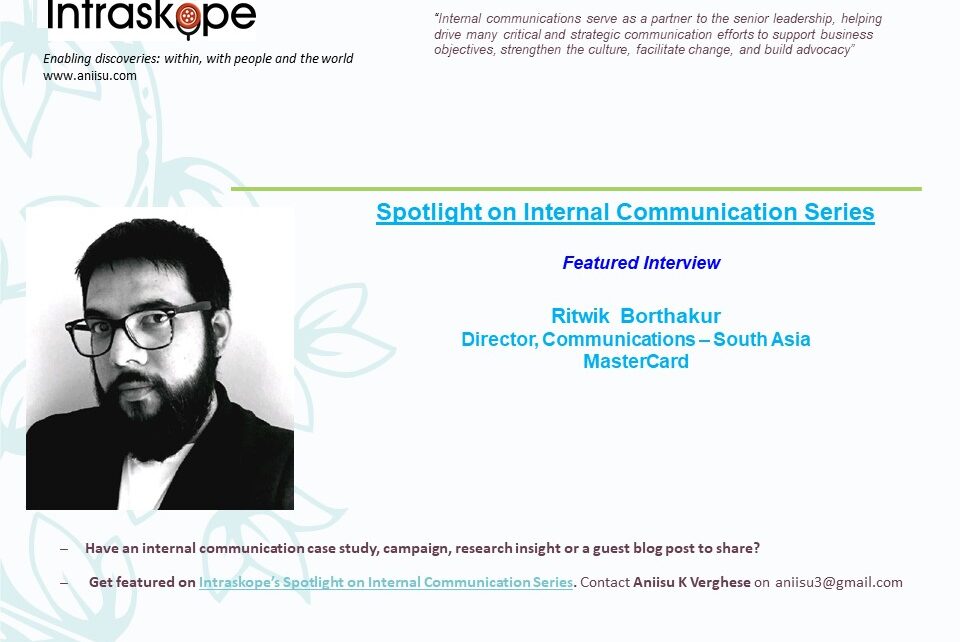Presenting the 44th edition of Intraskope’s Spotlight on Internal Communication Series featuring Ritwik Borthakur of Mastercard. Ritwik is a seasoned, strategic communications professional with over 12 years of experience in large and diversified, industrial and technology MNCs. He is a firm believer of creating organizational and brand narratives. In his role, Ritwik manages campaigns, events, employer brand and internal communications. Watch the complete video interview on YouTube or read the transcript below.
Interview
- What does internal communication mean to you?
A strategic function that designs, enables and drives valuable and consistent interactions between the organization and its most prized stakeholder – the employee. I often compare it to our personal (often overlooked but highly critical) internal dialogue. Like people, a truly healthy organization is usually aware, inspired, and connected ‘within’, and internal communications play a key role in making that happen.
2. How is it practiced in your organization?
Internal communications serve as a partner to the senior leadership, helping drive many critical and strategic communication efforts to support business objectives, strengthen the culture, facilitate change, and build advocacy. Mastercard truly considers employees as their biggest asset and our appreciate the importance of a proactive and consistent internal dialogue. The tools, techniques, and styles may vary but this key factor shapes the practice of internal communications. It enables one to take a strategic and deliberate approach to keep employees informed, engaged and inspired, and the senior leadership connected with them.
3. Please share an example/campaign that you are personally proud of working on and that made a significant impact to an organization in the recent past
There are many activities that the internal communications function drives – from regular stories and updates (through mailers, intranet, etc.), event-based internal campaigns, strategic leadership communication etc. I believe that approaching these everyday things with a solution-oriented approach – clearly defining objectives and KPIs – go a very long way. Often it is difficult to give examples from these ‘everyday’ activities (and they may sound less glamours) but if done right and consistently, these make a substantial impact, over time. I am particularly excited about programs that successfully meet a business need by being simple, flexible and most importantly sustainable. For instance, the story series we led in South Asia called Humans of Mastercard (inspired by Humans of NY) to showcase inspiring personal stories of our employees. I’m proud of the campaign as it could bring out the strength of our culture and what makes Mastercard a great place to work, not with self-attesting, corporate statements but through real human stories – presented in a simple, succinct and a sharable manner. It also served to be a way to inspire our employees. The format of the campaign was flexible, so it could be adapted to suit certain themes, making these stories a great way to promote other campaigns and initiatives. A case in point is the series of stories we did leading up to the International Women’s Day to help drive messages and events around inclusion and diversity.
4. What is the biggest challenge you face while going about managing internal communication?
The most widely acknowledged challenge today is to cut through the clutter and engage an audience that is already very busy. And, to do so in a way that’s meaningful. In many cases technologies and platforms available to communicate internally can make it harder. I think the only way to consistently do so is by keeping things simple and fresh – experimenting with new approaches to content and the medium. This challenge shall always remain and should push us communication professionals to keep reinventing and pushing for a better way.
5. What according to you is the biggest opportunity that internal communicators have?
The onset of a new-normal owing to COVID-19 has accelerated the adoption of digital interactions and I see this as a huge opportunity going forward. This is likely to fuel a wider and deeper penetration of virtual technologies and transform the way we connect and tell stories. The field of communication is evolving fast to become more social, interactive and measurable and the possibilities here are endless. Another area of opportunity is in nurturing employees as ambassadors of the company. Employees are the most trusted information source for any organization and serve as reliable advocates for the culture and the employer brand.
6. How can internal communicators add more value to the business?
As communicators, we get to work closely with the senior leadership while also collaborating across various other functions. I consider this a position of privilege and one that empowers us to contribute to organizational growth and make a real difference. This can enable communicators to not only take an important seat at the strategy table but also design and drive innovative programs that are interdisciplinary, cross-functional, and with potential to deliver impact at scale.
7. What skills must they have or develop?
Three things that I consider most vital for communicators – first, being flexible to adapt to different styles of content and technology – this helps one remain agile and keeps the saw sharp. Second, know your organization, its business and markets very well – it goes a long way in taking a more informed and strategic approach to communications and becoming a trusted partner to your senior leadership. Three – the ability to work across functions, influencing without a chain of command. These when combined can help achieve results that truly matter.
8. What is your advice for people who are keen to join internal communication and make a career?
Internal Communications is a niche field and is usually comprised of small teams (many a times a one-person show). It needs a specific skillset, which over time I’ve realized, is more about business acumen and active listening. As technologies evolve, it is also getting more analytical. Usually those who express interest in a filed like this (at least in my experience) are individuals who love writing or have a creative bent of mind. While both these are very important, my advice to those keen to join internal communications is to be to totally open to learning. Refer to real business cases and grow a knack for how organizations and businesses work. Educate yourself online, not just acquiring certifications but going through interviews of comms and marketing professionals, websites such as this one and reading books. If you are in college, take an internship. If you are looking for a career shift, take up stretch assignments.
9. With COVID-19 and other crises, how must internal communications engage? What has changed or will change? Examples of how your organization has helped reassure employees and navigate the crisis as it unfolds.
Usually there are standard procedure that are followed in times of crises and communications forms a critical part of cross-functional Crisis Response Teams within organizations. Every crisis requires one to act with caution for the situation at hand as well as empathy for those impacted. But the current crisis owing to COVID-19 is unlike anything the world has seen before – shifting paradigms in the very way we work and live. Communicators across the world are busier than ever as they drive consistent, critical communications in an ever-evolving scenario, while striving to keep employees informed, inspired and engaged. At Mastercard, it has been a well-orchestrated effort with teams across the region working together to communicate, proactively, regularly and timely with employees – be it memos from leaders on important updates; global, regional and local townhalls led by executive leaders hosting live Q&As or an active intranet portal that serves as a central point for latest updates, videos and inspiring stories employee stories from the new normal.
10. If there is one aspect of internal communications you would like to change, what would that be?
I would love to see more organizations realize the importance and the potential of a high-performing internal communications function. The onus for this is on us – communicators. We can move the needle when we lead by example.
Liked the interview? Post your comments and share it with your network.
Keen to contribute and participate in the ongoing series on Intraskope where we put the spotlight on thought leadership, great ideas, and practical solutions? Look up the previous stories from organizations featured on the Intraskope’s Spotlight on Internal Communication Series here – Northern Trust, AXA Business Services, Subex, global insurer, Standard Chartered Bank, BASF, Applied Materials India, Microsoft UK, Times Group, Samsung, Falabella, Cisco, Brillio, UAE Exchange, Apeland, M.H. Alshaya Co, Proctor & Gamble, Infosys, SOBHA Ltd., ICICI Securities, First Advantage, CK Birla Group, TVS Motors, GE, Suzlon, Tata Sons, Percept, Knight Frank, TCS Europe, Vedanta, Oxfam, Danske Bank, Diageo, Pandora, Symantec, ISS Global Services, Telia, Thomson Reuters, IBM, General Motors, Intelligence India Software Solutions, Philips and Refinitiv.
Intraskope (www.aniisu.com) is the first blog on internal communications in India and among the earliest around the globe. Begun in 2006, the blog has over 1000 posts on topics such as employee engagement, leadership communication and employee branding and receives thousands of visits from across the world. The blog, receives over 1,50,000 visits every month from over 50 countries globally, offers learning resources for practitioners, academicians, and students including industry workshops, research reports, and checklists.
Intraskope has been featured on leading global internal communication forums like Simply-Communicate, IC Kollectif and International Association of Business Communicators. It is hosted by Aniisu K Verghese, author of Internal Communications – Insights, Practices & Models (Sage, 2012).
If you are an internal communication leader working in a firm or a not-for-profit anywhere in the world and have an internal communication case study, campaign, research insight or a guest blog post to share please contact me on [email protected]
Here are Internal Communications resources you can use:
• Internal Communications Series: https://forms.gle/KcqmPzLwq7NQi5Km6
• Chat with Aniisu – Internal Communications: https://www.instamojo.com/intraskope/connect-with-aniisu-60-minute-personalized-d/?ref=store
• Internal Communications workshops: https://bit.ly/2zdBRl1
You can also visit my website www.intraskope.com and You Tube channel to know more about my work.

